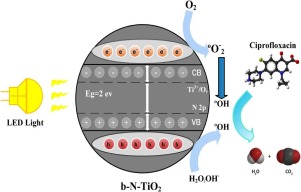当前位置:
X-MOL 学术
›
Process Saf. Environ. Prot.
›
论文详情
Our official English website, www.x-mol.net, welcomes your
feedback! (Note: you will need to create a separate account there.)
Enhanced photocatalytic degradation of ciprofloxacin by black Ti3+/N-TiO2 under visible LED light irradiation: Kinetic, energy consumption, degradation pathway, and toxicity assessment
Process Safety and Environmental Protection ( IF 6.9 ) Pub Date : 2020-05-01 , DOI: 10.1016/j.psep.2020.02.030 Mansour Sarafraz , Morteza Sadeghi , Ahmadreza Yazdanbakhsh , Mostafa M. Amini , Mohsen Sadani , Akbar Eslami
Process Safety and Environmental Protection ( IF 6.9 ) Pub Date : 2020-05-01 , DOI: 10.1016/j.psep.2020.02.030 Mansour Sarafraz , Morteza Sadeghi , Ahmadreza Yazdanbakhsh , Mostafa M. Amini , Mohsen Sadani , Akbar Eslami

|
Abstract In this work, the photocatalytic degradation of ciprofloxacin (CIP) by black Ti3+/N-TiO2 under visible LED light irradiation (b-N-TiO2/LED) was studied for the first time. Characterization of the prepared photocatalyst was performed by XRD, UV–Vis DRS, FE-SEM, EDS, HRTEM, and BET techniques. The b-N-TiO2 nanoparticles with high surface area of near 100 m2 g−1 and narrow band gap of 2.0 eV, exhibited a remarkable photocatalytic performance on the degradation (100 %) and mineralization (82 %) of CIP under visible LED light irradiation. The maximum degradation was found at reaction time = 70 min, initial CIP concentration = 0.5 mg L−1, pH = 6.7, and catalyst dosage = 0.43 g L−1. Based on the results, both the hole (h+) and hydroxyl radical ( OH) played a major role than the superoxide radical ( O2−) in CIP degradation. Although common coexisting anions in water had a slight negative effect on CIP degradation; humic acid (HA), especially in higher amounts, showed a considerable inhibitory effect on degradation process. Besides, the intermediates of CIP degradation were ultimately transformed into simple compounds. Accordingly, toxicity assessments revealed that the treatment of CIP solution by b-N-TiO2/LED process remarkably resulted in diminished toxicity compared to the untreated controls. The energy utilized in this study was far less than that used in other studies. Moreover, we found that b-N-TiO2 had desirable stability and can be reused for more than five runs of experiments. Collectively, based on our findings, the b-N-TiO2/LED process is a promising, low cost and feasible candidate can be used for degradation and mineralization of antibiotics like CIP in real water samples.
中文翻译:

可见 LED 光照射下黑色 Ti3+/N-TiO2 增强光催化降解环丙沙星:动力学、能耗、降解途径和毒性评估
摘要 本工作首次研究了黑色Ti3+/N-TiO2在可见光LED光照射下(bN-TiO2/LED)光催化降解环丙沙星(CIP)。通过XRD、UV-Vis DRS、FE-SEM、EDS、HRTEM和BET技术对制备的光催化剂进行表征。具有接近 100 m2 g-1 的高表面积和 2.0 eV 的窄带隙的 bN-TiO2 纳米粒子在可见光 LED 光照射下对 CIP 的降解 (100%) 和矿化 (82%) 表现出显着的光催化性能。在反应时间 = 70 分钟、初始 CIP 浓度 = 0.5 mg L-1、pH = 6.7 和催化剂剂量 = 0.43 g L-1 时发现最大降解。根据结果,空穴 (h+) 和羟基自由基 (OH) 在 CIP 降解中都比超氧自由基 (O2-) 起主要作用。虽然水中常见的共存阴离子对CIP降解有轻微的负面影响;腐殖酸 (HA),尤其是较高量的腐殖酸,对降解过程显示出相当大的抑制作用。此外,CIP降解的中间体最终转化为简单的化合物。因此,毒性评估表明,与未处理的对照相比,通过 bN-TiO2/LED 工艺处理 CIP 溶液显着降低了毒性。本研究中使用的能量远低于其他研究中使用的能量。此外,我们发现 bN-TiO2 具有理想的稳定性,可以重复使用超过五次的实验。总的来说,根据我们的发现,bN-TiO2/LED 工艺是一种很有前途的,
更新日期:2020-05-01
中文翻译:

可见 LED 光照射下黑色 Ti3+/N-TiO2 增强光催化降解环丙沙星:动力学、能耗、降解途径和毒性评估
摘要 本工作首次研究了黑色Ti3+/N-TiO2在可见光LED光照射下(bN-TiO2/LED)光催化降解环丙沙星(CIP)。通过XRD、UV-Vis DRS、FE-SEM、EDS、HRTEM和BET技术对制备的光催化剂进行表征。具有接近 100 m2 g-1 的高表面积和 2.0 eV 的窄带隙的 bN-TiO2 纳米粒子在可见光 LED 光照射下对 CIP 的降解 (100%) 和矿化 (82%) 表现出显着的光催化性能。在反应时间 = 70 分钟、初始 CIP 浓度 = 0.5 mg L-1、pH = 6.7 和催化剂剂量 = 0.43 g L-1 时发现最大降解。根据结果,空穴 (h+) 和羟基自由基 (OH) 在 CIP 降解中都比超氧自由基 (O2-) 起主要作用。虽然水中常见的共存阴离子对CIP降解有轻微的负面影响;腐殖酸 (HA),尤其是较高量的腐殖酸,对降解过程显示出相当大的抑制作用。此外,CIP降解的中间体最终转化为简单的化合物。因此,毒性评估表明,与未处理的对照相比,通过 bN-TiO2/LED 工艺处理 CIP 溶液显着降低了毒性。本研究中使用的能量远低于其他研究中使用的能量。此外,我们发现 bN-TiO2 具有理想的稳定性,可以重复使用超过五次的实验。总的来说,根据我们的发现,bN-TiO2/LED 工艺是一种很有前途的,











































 京公网安备 11010802027423号
京公网安备 11010802027423号